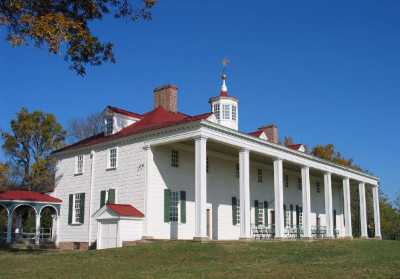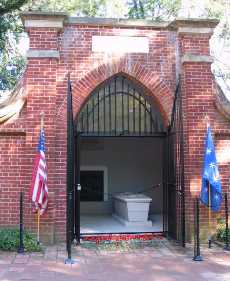Home | News | Books | Speeches | Places | Resources | Education | Timelines | Index | Search
© Abraham Lincoln OnlineMount Vernon
Mount Vernon
VirginiaThe sprawling Potomac River estate of George Washington, America's first president, became a tourist destination even while he was alive, despite the rigors of eighteenth-century travel. Long after his death in 1799, it continued to attract visitors from many regions and countries, including Abraham and Mary Lincoln.
Still immmensely popular and convenient to Washington, D.C., you can travel to it as the Lincolns did, by land and by boat. The restored home faces the river and features its own dock.
Lincoln's February 1848 Visit
The earliest known visit of Abraham Lincoln to Washington's house and grounds came while he served Illinois as a U.S. Congressman. Lincoln gained some unexpected free time when Congress recessed after John Quincy Adams died on February 23. Israel Washburn, one of three politically prominent brothers from Maine who settled in the Midwest, remembered seeing Lincoln in Washington during this period.
Washburn traveled to Washington for Adams's funeral and stayed at the National Hotel on Pennsylvania Avenue. He recalled that Lincoln "visited us at our rooms and told us of his overland trip that day to Mt. Vernon. He staid nearly two hours and was very pleasant."
Visits During Lincoln's Presidency
About a year before Lincoln became president, the Mount Vernon Ladies' Association took possession of Washington's estate to preserve and restore it. At this point the house was virtually empty and needed extensive repairs. The association purchased the property from John Augustine Washington III, the general's great-great nephew, who was killed in September 1861 while serving in the Confederate Army.
When Lincoln was inaugurated on March 4, 1861, some of his wife's relatives stayed at the White House during the festivities. As the month wore on, only a handful of them remained, and they were anticipating a trip to Mount Vernon. On March 20 one of Mary's cousins wrote home, "We have had a boat at our disposal for several days to pay a visit to Mount Vernon, but so many things have interfered to keep us home."
The following week while President Lincoln remained in Washington, Mary took her guests to the estate on the steamer Thomas Collyer. The boat's captain escorted the party over the grounds. According to Sarah Tracy of the Mount Vernon Association, the estate's superintendent "was very polite to them, took them in the Banqueting room, and General Washington's room, and the gardens. His dinner was just ready, and he gave them a little lunch, of bread, butter and 'Ham.' On the whole they had a very pleasant time." The start of the Civil War was still a few weeks off, so when Mary wrote a letter mentioning the trip she did not express any safety concerns and expected to return.
On December 12, 1861, John Dahlgren of the Washington Navy Yard accompanied some Cabinet members and guests to Mount Vernon. He wrote in his diary, "As the position of our forces here was by no means assured, I considered it very hazardous for such important functionaries to go ashore. However, the whole party went, except him of War, who quietly remained in the steamboat in mid-river."
In February 1862 Julia Taft, a friend of the Lincoln family, went on a picnic to Mount Vernon with ladies from the newly commissioned Fort Foote across the Potomac River. Their enjoyable day was shortened by the appearance of Confederate troops and she wrote about being "hustled down into our boat, and just in time, too, to escape Early and his greycoats whom we saw in the woods. The two orderlies who had stayed behind to bring the lunch baskets down to the landing were captured and spent two years in Libby prison."
Following the February 20, 1862 death of 11-year-old Willie Lincoln, some of Mary Lincoln's relatives again were in town. On Wednesday, April 2, Dahlgren reported going to Mount Vernon "with the President, some members of his family, and others. I advised the President not to land, and remained in the boat with him." Although the property was considered neutral territory during the war, substantial security issues remained, so it is unlikely that Lincoln visited the estate during his presidency.
Lincoln's Last Sight of Mount Vernon
In early April 1865 President Lincoln visited General Grant's headquarters on the James River and entered Richmond after the Confederates fled. As he returned to Washington, he and his party aboard the River Queen sailed by Mount Vernon. It was April 9, the day that General Lee surrendered to Grant, and just five days before Lincoln would be assassinated. The Marquis Adolphe de Chambrun, a Frenchman traveling with the Lincolns, made what turned out to be a prophetic statement: "Mount Vernon, with its memories of Washington, and Springfield, with those of your own home -- revolutionary and civil war -- will be equally honored in America." At this, the weary president responded, "Springfield, how happy I shall be four years hence to return there in peace and tranquility!" No one could guess that Lincoln would be in Springfield only a month later in the new town cemetery.
© Abraham Lincoln OnlineWashington's Tomb The British writer William Russell described the tomb of George and Martha Washington during a trip on April 2, 1861. "It is a plain brick mausoleum, with a pointed arch, barred by an iron grating, through which the light penetrates a chamber or small room containing two sarcophagi of stone. Over the arch, on a slab let into the brick, are the words: 'Within this enclosure rest the remains of Gen. George Washington.' The fallen leaves which had drifted into the chamber rested thickly on the floor, and were piled up on the sarcophagi, and it was difficult to determine which was the hero's grave without the aid of an expert, but there was neither guide nor guardian on the spot. Some four or five gravestones, of various members of the family, stand in the ground outside the little mausoleum. The place was most depressing."
Lincoln apparently visited the tomb site in 1848. The Kansas Historical Society owns a branch he took from the area as a souvenir. Lincoln gave the branch to William Henry of Vermont, a Whig party politician who served with him in the Thirtieth Congress. Henry turned the branch into a cane, which passed to his daughter, who donated it in 1893.
Visiting Information
Mount Vernon is open 365 days of the year, but hours vary slightly according to season. Check the official website for details, as well as travel tips, events, food service, and educational opportunities. Admission is charged. The estate is located 16 miles south of Washington, D.C.
Home | News | Education | Timelines | Places | Resources | Books | Speeches | Index | Search Text and photos copyright © 2019 Abraham Lincoln Online. All rights reserved. Privacy Policy


